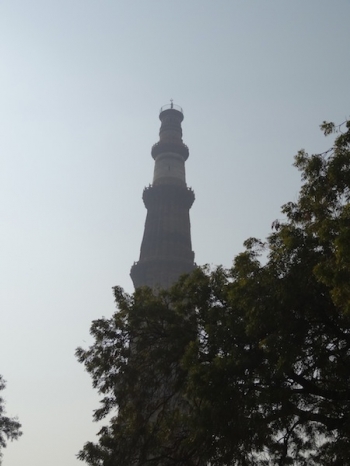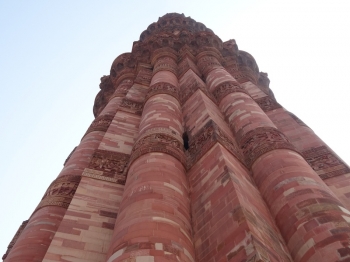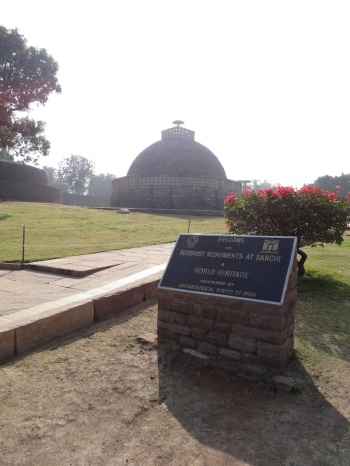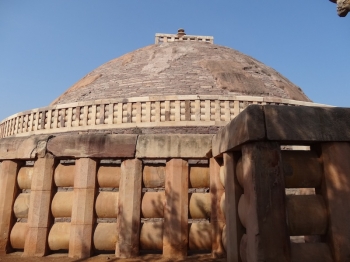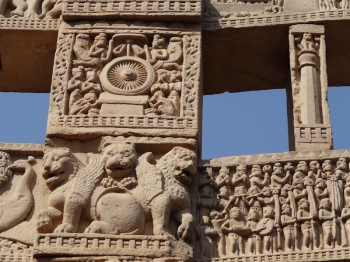For millennia, awesome structures have reached for the sky and the stars beyond heaven. Religious towers like ziggurats or pyramids were believed to embody an adored ideal. Even today's skyscrapers are well known to be phallic, linga-esque projections of capitalist virility and that most sacralized of enterprising saints, the entrepreneur. But before skyscrapers, two dissimilar kinds of tower co-existed in India to commemorate very different visions of the world and afterlife.
Of far more ancient pedigree is the stupa, a reliquary of varying size and complexity that holds the Buddha's relics (and later on, those of more influential monks, nuns, or donors). Originally a simple funerary mound that predated Buddhist customs, the stupa has since become a signature Buddhist structure, evolving into the famous pagodas of East Asia and chorten in Tibet. The younger is the minaret, which is not a standalone structure in its own right but part of the Islamic mosque. As the tallest brick minaret in the world and the loftiest minaret in India, Qutub Minar has a long and illustrious history dating back to the twilight of Hindu rule in India: for that is what the history of this magnificent nation is all about; a timeless battlefield of rising and falling kingdoms, empires, and republics.
Of far more ancient pedigree is the stupa, a reliquary of varying size and complexity that holds the Buddha's relics (and later on, those of more influential monks, nuns, or donors). Originally a simple funerary mound that predated Buddhist customs, the stupa has since become a signature Buddhist structure, evolving into the famous pagodas of East Asia and chorten in Tibet. The younger is the minaret, which is not a standalone structure in its own right but part of the Islamic mosque. As the tallest brick minaret in the world and the loftiest minaret in India, Qutub Minar has a long and illustrious history dating back to the twilight of Hindu rule in India: for that is what the history of this magnificent nation is all about; a timeless battlefield of rising and falling kingdoms, empires, and republics.
Just as the Great Stupa of Sanchi was one of the most important monuments that marked Emperor Asoka’s newfound sympathy for Buddhism, the mosque at the Qutb site (Quwwat-ul-Islam Mosque) was the first Muslim house of worship to be built by the sultans of Delhi. Having wrenched territory from Hindu rivals and enjoyed the spoils of his newly conquered land, the Mamluk ruler, Qutbu’d-Din Aibak, built the accompanying minaret in 1198 AD. The objective of this structure, along with all the others at the Qutb site, was simple: to demonstrate Mamluk devotion to their God. This has been the purpose of many forms of Islamic architecture. And so Qutub Minar was intended to be a tower of victory, commemorating Qutbu’d-Din Aibak’s superior, Mohammed Ghori, over the Rajput king Prithviraj Chauhan. Hence both the stupa and the Tower seem to serve political as well as religious purposes: for Emperor Asoka, his newfound vocation was to unite ancient India through “conquest by Dharma”, whilst for the Mamluk Dynasty, their minaret was a celebration of their military conquest over polytheistic infidels. Ironically, neither the Great Stupa nor Qutub Minar have any religious significance; their grand reputation was molded only by their founding monarchs and subsequent communities.
Both the stupa and minaret call the believer to a higher good: for Buddhists, the most natural instinct upon seeing a stupa is to circumambulate it, which is simply moving around a sacred object. A
All stupas are three-dimensional mandalas, and the cosmic significance of the Sanchi stupas is apparent when one examines each of the four gates. Four Buddhas at each gate: one Buddha for each direction. At the center of the four directions is the Sage himself, the historical Buddha we call Sakyamuni and his relics, his enshrined presence that endures until the final disappearance of Dharma. But even this disappearance of the Dharma is not the end of the story, as Buddhist history is cyclical: the Dharma will appear once more the world renewed. Until that distant day, stories of Buddha’s glory deck the stupa gates, recounting his Jataka lives as well as his final descent to our suffering world. And of course, in the Muslim world, the minaret is an instant, visual cue to the purpose human beings were created for, and the allegiance they owe to Allah.
The lasting (and indeed, ubiquitous) presence of stupa and minaret just goes to show how deeply religious piety suffuses even the dead faces of Indian civilization. Even in the democratic, entrepreneurial society of this secular republic, gods remain and dwell in the majority of people. Long have India’s competing empires died, but the search for divine friendship, worship and prayer continues.
